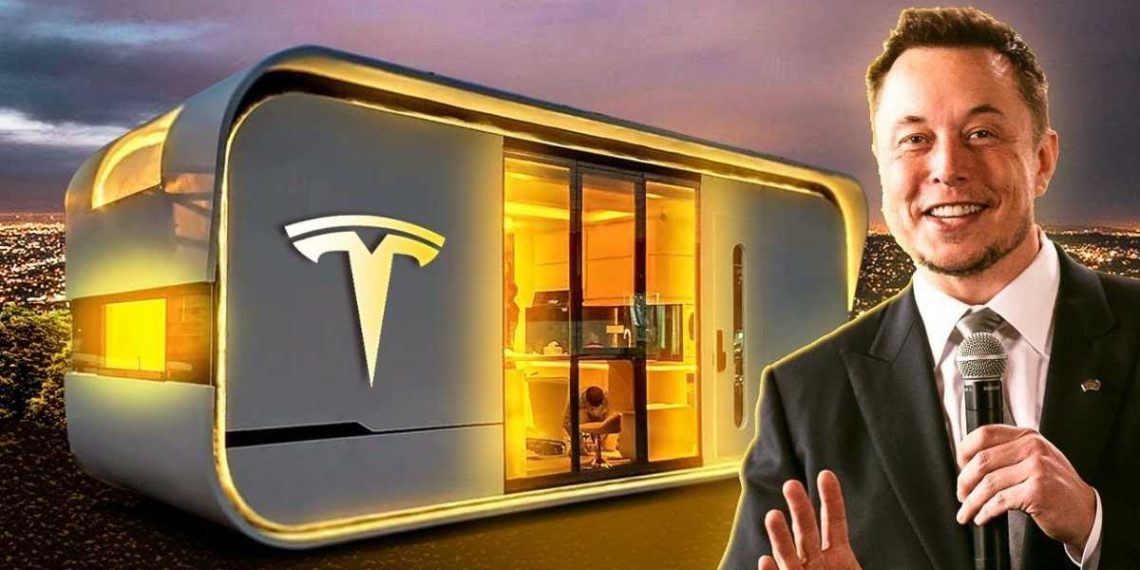The Tesla company has been creating sustainable living products and services since they were founded in 2003
So, it’s no surprise that their new $15,000 house (initially planned at $33,000) is an extremely environmentally friendly house for the masses.
What is Tesla Energy?
Tesla Energy is a new suite of batteries designed to store sustainable power onsite. The most affordable option—the Powerwall—is designed to work in conjunction with solar panels and provide backup power when your utility goes down.
Tesla Powerwall
The larger Powerpack is targeted at commercial customers like large businesses or cities that can use grid-tied storage systems to cut costs while increasing overall sustainability. The price of all Tesla Energy products starts at just $3,500 for 10kWh for Powerwall and scales up from there depending on size and capacity. We are trying to change energy consumption fundamentally by saying you no longer have to burn fossil fuels, you don’t have to be dependent on utility companies, said Elon Musk. You should be able to take your power generation everywhere you go.
No matter where you live, as long as it’s connected to a grid which has got lots of wind and solar generation, which obviously it should since we want to reduce CO2 emissions. You should always have that with you wherever you go so if something happens—like a hurricane destroys your house and knocks out power—your Tesla battery can save your home…With Tesla Energy, we want to turn things upside down. Instead of using dirty energy for transport – try clean energy!
Who is Tesla Energy For?
While Tesla may be best known as a company that makes electric cars and batteries to power them, it also designs and sells all sorts of other equipment.
The company has solar panels, wall-mounted battery packs to store energy that it makes during off-peak hours, large batteries that can be integrated into new construction or retrofitted into existing homes and businesses. And now comes news that Tesla is getting into the home building—well sort of. It’s making an affordable house designed for sustainable living that is built on a platform called Tesla Energy. The design incorporates all kinds of efficiency measures including lights and appliances powered by solar energy.
All told, these features allow it to generate more energy than it needs while still costing less than most houses out there. More on Tesla’s New House: Calling attention to green tech isn’t new territory for Elon Musk’s Tesla. Last year it collaborated with SolarCity Corp., also run by Musk, to sell a solar roof product whose price competes with conventional roofing materials, according to Bloomberg News. Prices start at $21 per square foot before incentives and rise into five figures depending on how much electricity you want your house producing over its lifetime of 30 years or so, according to SolarCity’s website.
How Much Does A Tesla Home Cost?
You’ve probably heard about Elon Musk and Tesla changing how we get from point A to point B.
What you may not know is that they are also trying to change how we live. From solar panels on every roof to electric cars in every garage, they’re looking toward a future where our planet doesn’t become a smoldering cinder. The latest step? Affordable green homes built by Tesla! Their first model was just unveiled in California and it costs $15,000. It’s made with standard parts (like plywood and polyurethane insulation) which helps keep things affordable while still feeling ultra-modern. There’s plenty of room inside, so it works well as either an apartment or a house. Your new home will come equipped with everything you need: a shower, bed, and plenty of space for kitchen equipment—all powered by free solar energy! Let’s take a look at what makes these sustainable houses tick
Should You Buy A Tesla Home?
Elon Musk wants to sell you a house. And it won’t cost that much either.
The Tesla founder revealed his electric car company’s latest plans at an event Wednesday night in Los Angeles. This time, Musk is taking on renewable energy and sustainable living with Tesla houses—100% self-sufficient dwellings that come with solar panels and battery storage technology built into power your lights, appliances, and more. It’ll start at $49K but can be more depending on how much room you need and of course if you add extras like a rooftop deck or extrasolar tiles. While many of these new products from Tesla won’t ship until 2023(or further out), we had lots of questions about Musk’s ideas, so we reached out to Tesla for details.
Here are answers to all our burning questions. While there have been plenty of problems and delays along those lines already with Tesla cars, there’s no reason to think Tesla can’t bring affordable batteries and solar tech down even further than where they are now. So get ready: If everything goes according to plan (and sometimes things do) we could see viable large-scale home battery packs by 2022—that could mean less reliance on traditional utilities forever.
Can I Use My Existing House to Store Electricity From Solar Panels?
Yes. This is called energy arbitrage and it makes a lot of sense.
The price of stored electricity would depend on how much you produce versus how much you can consume at any given time as well as what your utility charges you per kWh and how far away your house is from them. If there were enough people that did it and charged their EV’s overnight then they could eliminate almost all their peak demand usage (or get paid by their utility to do so) which would help utilities meet peak demand periods much easier since they wouldn’t have to build nearly as many power plants to deal with them.
That might lower everyone’s power bills but especially those who had solar panels because they’d be getting paid rather than paying someone else to not use their own excess electricity production. While I don’t know specifically how Tesla wants to implement charging EVs using solar panel arrays but I’m assuming that during daylight hours when most people aren’t home and maybe only electric cars are around will likely mean that you’ll get paid more for putting extra electricity into your battery pack compared to if everyone arrived home from work around 6 pm at night or something like that and didn’t have time left in their day to recharge before going out again later in the evening. It sounds like it’d be a smart business model from a utility’s point of view too.
Is My Current Roof Good Enough For Solar Panels?
Roofs of all shapes and sizes can be outfitted with solar panels. But sometimes homeowners are hesitant to install them on an older roof;
they don’t want to spend thousands of dollars on a new roof just so they can save some money on electricity. But do you really need a new roof? For those who are unsure, here are some questions you should ask yourself: What’s my roof made of? Does it have shingles or tiles? If so, what kind of shingles or tiles is it? Is it wood or metal? Are there any visible cracks in its foundation? Older roofs tend to last 10-20 years before needing replacement; if your home was built after 2010 then it should have a lifespan of at least 50 years.
That said, depending on your climate (more rain/snowfall means quicker deterioration) a 15-year old roof might already be worn down. While not everyone will agree with us, we recommend getting estimates from different contractors to see whether or not you’ll need a new roof anytime soon. It may very well turn out that yours is sturdy enough! This will make it easier to decide whether or not investing in solar energy makes sense for you…if not now, then maybe later when you know whether or not that old thing still has life left in it yet!
How Long Will My Solar Panels Last?
We get asked a lot about solar panel longevity. How long will my solar panels last?
The answer depends on your local climate and conditions. But in general, your solar panels should last between 20-25 years or more! Let’s take a look at a few factors that can affect how long your panels will last: Heavier snowfall and ice – If you live in an area that experiences heavier snowfall and ice than usual then you may want to ask your installer if they are using top quality solar panels rated to withstand heavy snow loads. In general, we recommend looking at brands like Canadian Solar or Kyocera Solar Panels. Depending on where you live, however, it is possible some manufacturers have better heavy load ratings than others.
A good installer will be able to tell you which panels are rated for heavy snow loads. Hail – Hail isn’t just bad for cars; it is also bad for solar panels. Hail damage has been known to destroy entire arrays so again it is important to choose a high-quality solar panel that has been tested by hail storms and proven itself able to endure hail storms well over time (greater durability). Wind Damage & Tower Failures – Most installers today use fairly strong towers that can withstand significant wind gusts (typically up to 90+ MPH). However, tower failures do happen occasionally when trees collapse or large trucks hit towers sending them tumbling down.
Is it Easier To Finance A Solar Panel System than an Electric Car?
Tesla’s new solar roof is a game-changer. It finally allows homeowners to replace their roofing with an aesthetically pleasing and durable alternative – one that also happens to be made from solar panels.
Not only that, but because it produces electricity to power your house and home battery storage system, Tesla has built-in additional value: you can power your home with 100% renewable energy AND lower your electricity bill. So how does it compare to financing a Tesla electric car? Well…it depends on how much you drive! The Tesla Model S 75D costs between $75,00 – 90,000 after Federal Tax credits and includes 300+ miles of range.
A Tesla Powerwall 2 home battery starts at around $6,500 (after tax credits) and should give you peace of mind in case of a long period without sunshine or when everyone in your household wants to use something at once (electric dryer + dishwasher + washer + computer). Financing both through SolarCity or another provider would probably put you somewhere around $30k – 35k in total cost (with installation included), which is still cheaper than most electric cars. Of course, prices could go down over time as demand goes up so stay tuned! Plus, Tesla’s line of batteries is compatible with other SolarCity products including solar panel systems and inverters. These additions will significantly cut down installation costs while providing more versatility during times of low or no sun.
With Tesla’s newly announced loan plan (link below), paying off these systems might actually be easier than paying off your EV every month! All told, if you’re looking for ways to go green without breaking the bank, Tesla’s latest innovations may just have what you need. But make sure to do your homework first – Musk has said he sleeps easy knowing people are using his products responsibly; not being able to afford them doesn’t mean someone isn’t trying hard enough! Why Tesla Got Into Home Batteries and Roof Tiles: When Tesla CEO Elon Musk introduced the company’s new solar shingle tiles last October, he noted that they were designed to look good even without solar cells by mimicking traditional roofing materials.
Now we know why. On Friday night, Bloomberg reported that Tesla had begun taking orders for two different versions of its glass tile roofs—and each costs less than half as much as installing comparable photovoltaic systems elsewhere on a rooftop today. Customers must apply to be part of a waitlist and pay a $1,000 deposit to reserve their spot in line. Tesla will then begin to customize designs before scheduling installations, which likely won’t happen until sometime next year. Tesla Solar Roof Is Affordable (Almost): One of Tesla’s solar roof offerings comes with three layers: ultra-efficient glass tiles, a textured protective layer that resembles slate or terracotta roofing, and a solar cell embedded into it all. Tesla has estimated that installation of a roof based on its prototype solar roof module would run about $42 per square foot—cheaper than standard asphalt shingles and certainly less than any metal or slate roof you could install on your home today.
- Πηγή: //techyfiction.com




